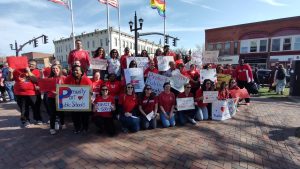Local Petitions Challenge REC Choice Fund Options
March 31, 2017
Local community members are pushing to overturn a recent initiative that would give city residents the option of donating revenue from renewable energy back to the city. A committee of city residents created two petitions that, if passed, would put the city’s Community Choice Fund back on next year’s ballot. The fund allows residents to donate their share of the city’s Renewable Energy Credits back to the City to invest in further sustainable energy projects.
Last year, City Council decided that Oberlin would return 85 percent of the proceeds from the sale of RECs to city residents and give 15 percent of the proceeds to sustainability projects, which comes out to around $100 per year for each resident. Renewable Energy Credits are certificates given when a one megawatt-hour of electricity is produced with renewable energy. These certificates can be bought and sold on the open market and have garnered the city $2.6 million.
John Elder, a Kendal at Oberlin resident and leader of the committee that created the petitions, believes it is a much better idea to direct all of the REC money back to renewable energy programs.
“The benefit for the rate payers of Oberlin is much greater if we were to develop more programs like [Providing Oberlin With Efficiency Responsibility], that will save owners money in the long run and help save the environment,” Elder said. “The fund uses REC money for large-scale, long-term conservation programs that benefit the whole community. This is money the city needs for projects to meet our Climate Action Plan goals.”
Elder said another issue with the choice fund is that proceeds from the RECs are divvied up based on energy usage, meaning a greater portion of the proceeds would go to large facilities like the College, Kendal at Oberlin and Walmart, which could decide to simply not donate any of it back to the fund.
However, city councilmembers viewed the Choice Fund as a good way to appease both those that want to donate back or benefit from the additional revenue.
“Our consumers must share the burden when costs go up, it seemed only fair that they share the benefit of these REC dollars,” Councilwoman Sharon Fairchild-Soucy said. “If [the petitions were] successful, the hard work and months of discussion that went into the compromise would be negated and all efforts to turn REC dollars into active programs would be stalled. I believe council’s compromise represents a sound, balanced and fair program for residents.”
Finance Director Sal Talarico believes that community members may misunderstand what REC dollars can be used for.
“The community may have the assumption that the dollars can be used for private homes, private businesses and private purposes,” Talarico said. “But it has to be related to the public utility. If that nexus isn’t there, it would be illegal to donate those dollars. That’s why we created the Choice Fund as a compromise so that the dollars would go back to the ratepayers. If we keep the dollars, we have to make sure the dollars are spent in accordance with the law. If we give them back, we have more flexibility. I can work with either option.”
Fairchild-Soucy added that part of the problem with forcing all RECs into the city’s fund is that not all city residents can afford to do away with what would be $10 per month if they received the funds.
“It’s a little bit of a class issue since the people who want to keep it all, all have made the statement that $10 doesn’t make a difference in the lives of citizens,” Fairchild-Soucy said. “But others say, ‘Who are you to tell me that $10 a month won’t affect me? It’s my money, I want to have the right to make that choice.’”
Talarico will send the petitions to the Lorain County Board of Elections for review, and if they are approved, the initiatives will be back on November’s ballot.


















